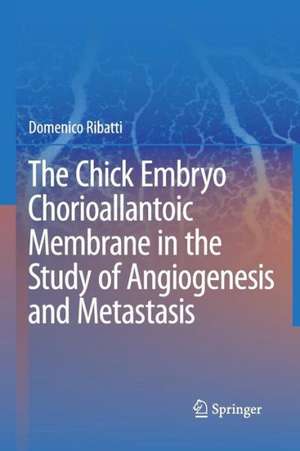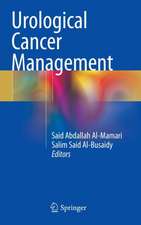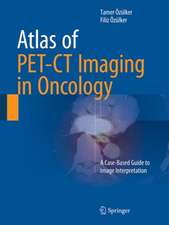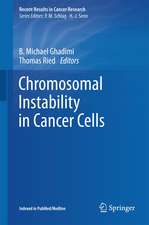The Chick Embryo Chorioallantoic Membrane in the Study of Angiogenesis and Metastasis: The CAM assay in the study of angiogenesis and metastasis
Autor Domenico Ribattien Limba Engleză Paperback – 28 oct 2014
| Toate formatele și edițiile | Preț | Express |
|---|---|---|
| Paperback (1) | 706.97 lei 6-8 săpt. | |
| SPRINGER NETHERLANDS – 28 oct 2014 | 706.97 lei 6-8 săpt. | |
| Hardback (1) | 711.72 lei 6-8 săpt. | |
| SPRINGER NETHERLANDS – 28 feb 2010 | 711.72 lei 6-8 săpt. |
Preț: 706.97 lei
Preț vechi: 744.18 lei
-5% Nou
Puncte Express: 1060
Preț estimativ în valută:
135.28€ • 140.96$ • 112.01£
135.28€ • 140.96$ • 112.01£
Carte tipărită la comandă
Livrare economică 03-17 aprilie
Preluare comenzi: 021 569.72.76
Specificații
ISBN-13: 9789400791572
ISBN-10: 9400791577
Pagini: 136
Ilustrații: X, 124 p.
Dimensiuni: 155 x 235 x 7 mm
Greutate: 0.2 kg
Ediția:2010
Editura: SPRINGER NETHERLANDS
Colecția Springer
Locul publicării:Dordrecht, Netherlands
ISBN-10: 9400791577
Pagini: 136
Ilustrații: X, 124 p.
Dimensiuni: 155 x 235 x 7 mm
Greutate: 0.2 kg
Ediția:2010
Editura: SPRINGER NETHERLANDS
Colecția Springer
Locul publicării:Dordrecht, Netherlands
Public țintă
ResearchCuprins
Chorioallantoic Membrane Vasculature.- Chorioallantoic Membrane in the Study of Angiogenesis, Antiangiogenesis, and the Vascularization of Grafted Tissues.- Chorioallantoic Membrane in the Study of Tumor Angiogenesis.- Chorioallantoic Membrane in the Study of Tumor Metastasis.- Other Applications of Chorioallantoic Membrane.- Different Morphological Techniques and Methods of Quantifying the Angiogenic Response Used in the Study of Vascularization in the Chorioallantoic Membrane.- Advantages and Limitations of Chorioallantoic Membrane in Comparison with Other Classical In Vivo Angiogenesis Assays.
Textul de pe ultima copertă
The chick embryo chorioallantoic membrane (CAM) is an extraembryonic membrane which serves as a gas exchange surface and its function is supported by a dense capillary network. Because of its extensive vascularization and easy accessibility, the CAM has been broadly used to study the morpho-functional aspects of the angiogenesis process in vivo and to investigate the efficacy and mechanisms of action of pro-angiogenic and anti-angiogenic natural and synthetic molecules. The CAM is a suitable site for transplanting tissues, which can survive and develop in the CAM by peripheral anastomoses between graft and original CAM vasculature or by new angiogenic vessels grown from the CAM that invade the graft. While the formation of peripheral anastomoses between host and pre-existing donor vessels is the main, and the most common, mechanism involved in the revascularization of embryonic grafts, the growth of CAM-derived vessels into the graft is only stimulated in tumor grafts. The CAM has long been a favored system for the study of tumor angiogenesis and metastasis, because at this stage the chick immunocompetence system is not fully developed and the conditions for rejection have not been established. Tumors remain avascular for 72 h, after which they are penetrated by new blood vessels and begin a phase of rapid growth. Also, delivery of tumor cells onto the CAM allows the fine study of the effects of tumor derived angiogenic growth factors on blood vessel structure and functionality. The CAM may also used to verify the ability to inhibit the growth of capillaries by implanting tumors onto the CAM and by comparing tumor growth and vascularization with or without the administration of an anti-angiogenic molecule. Other studies using the tumor cells/CAM model have focused on the invasion of the chorionic epithelium and the blood vessels by tumor cells. The cells invade the epithelium and the mesenchymal connective tissue below, where they are found in the form of a densebed of blood vessels, which is a target for intravasation.
Caracteristici
Several in vivo assays are currently used in the study of angiogenesis and antiangiogenesis The chick embryo chorioallantoic membrane is one of the most common and versatile assay to study angiogenesis and antiangiogenesis in vivo Angiogenesis plays a critical role in tumor progression and metastasis Antiangiogenesis is one of most promising approach to the treatment of cancer and metastasis










